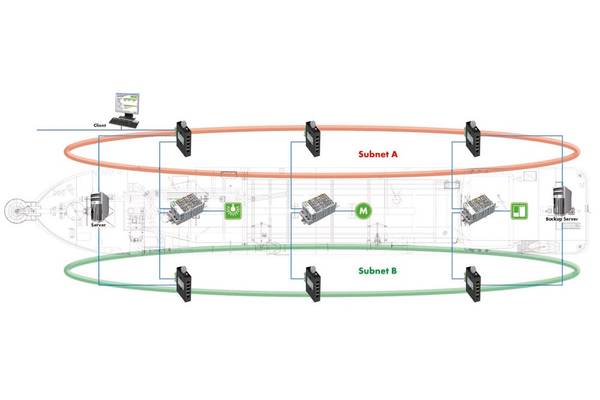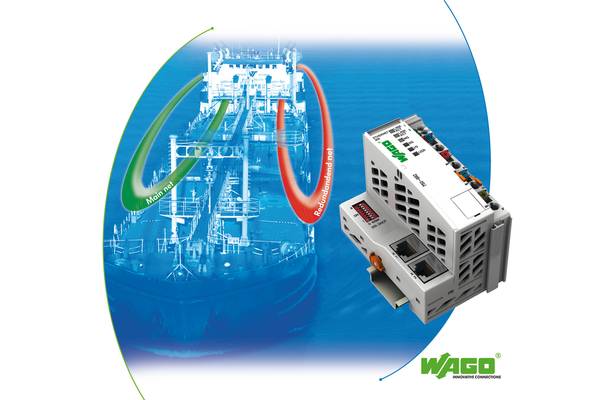

ETHERNET Controller helps Shipbuilders Meet ABS Network Redundancy Requirements
Safety-critical tasks place exacting demands on the performance, capability and availability of shipboard controls. Thus, the American Bureau of Shipping (ABS) requires network redundancy. If a wire breaks, triggering one network/server to fail, a redundant network becomes an additional communication path to provide uninterrupted operation. Historically, network redundancy has required extensive wiring and additional control components, which increases shipbuilding and maintenance costs. Now, ETHERNET-based programmable controllers are cost-effectively streamlining shipboard control via innovations in network redundancy.
Darryl Felder, Project Engineer for Baton Rouge Marine Electrical Service, Inc., employs advanced controllers, such as WAGO Corporation’s 750-882 ETHERNET 2.0 Network Redundancy Controller. 750-882 supports redundancy by simultaneously interfacing two ETHERNET-based networks. Felder is integrating 750-882 into a steering control project that requires network redundancy. Traditionally, two complete control nodes and an extensive multi-conductor infrastructure would be used. However, Felder sought the efficiency of 750-882’s two-cable architecture for streamlining data collection from the ship’s positioners.
Built-In Redundancy
“With the 750-882, you only need to run two cables, not 160 wires,” Felder said. “Redundancy is required — if you were to lose one cable, you’d lose all of the steering.” Felder insists that 750-882 could run ballast control and bluewater applications alike. The 750-882 carries ABS-Type approval, well as KR, GL and DNV Marine Certifications.
“750-882 makes it a whole lot easier to meet ABS requirements,” he explained. “With 750-882, you don’t need that second complete control node — it already has redundancy.” Because 750-882 requires just two cables, it reduces installation and maintenance expenses Felder said — no troubleshooting and tightening/retightening 160+ wires. 750-882 also reduces the control footprint for shipbuilders and system integrators. Using a previous ship lighting control project — which did not require network redundancy — Felder illustrated the impact of one redundant controller.
“If it were to require a complete second node for redundancy, about 25% more enclosure space would have been needed,” he estimated.
ETHERNET Comes Aboard:
750-882 hails from the WAGO-I/O-SYSTEM, which withstands magnetic fields, continuous vibrations/shocks, humidity and temperature fluctuations. With approvals from Germanischer Lloyd, Lloyd Register of Shipping, the American Bureau of Shipping, Nippon Kaiji Kyoka, Bureau Veritas, Det Norske Veritas and RINA, the system is certified for marine control. Felder himself has employed WAGO controllers and I/O modules for tasks such as wheelhouse monitoring.
A manufacturing mainstay, “distributed” ETHERNET-based control is gaining acceptance over conventional fieldbus solutions for marine applications. One of the reasons: flexible and open communication via standardized ETHERNET infrastructure. Also, Felder said, several shipping and petro firms utilize ETHERNET onshore. “These customers are already using servers that read ETHERNET-compatible communication protocols such as MODBUS/TCP,” he rationalized. “No additional servers or software while using existing networks and security measures, e.g., firewalls, saves a substantial amount of time and money.”
Another reason ETHERNET is gaining favor in shipbuilding: multi-client/server architecture that permits redundancy mechanisms while increasing availability. Redundancy is traditionally provided by duplicating both components and lines. Errors such as wire breaks no longer lead to control system failure, since alternative components or network connections are available. Cost-effective and compact, redundant network controllers provide shipbuilders with several benefits. These include advanced data transmission technologies that make high levels of component availability and safety possible.
Redundancy Procedures
To increase communication network availability, different redundancy procedures for ETHERNET-based networks are available, such as the Rapid Spanning Tree Protocol (RSTP) [IEEE 802.1D-2004], Media Redundancy Protocol (MRP) [IEC 62439-2], Parallel Redundancy Protocol (PRP) [IEC 62439-3] and others. A prerequisite for these, however, is that the ETHERNET network contains no closed loops or rings. Redundancy procedures open and close the loops or rings depending on the specific requirements.
RSTP: used in complex network topologies to disable redundant paths. When a link failure occurs, RSTP determines the best paths via communication costs (telegram propagation times) and priorities, while reactivating the required paths. The switch-over time required for RSTP ranges from 1–3 seconds.
MRP: used in a ring topology in which a central switch (Master) closes the ring in case of a network failure and reopens it once the failure is corrected. The switch-over time required for MRP is between 200 and 500 milliseconds.
PRP: communicates via two parallel networks, while transmitting telegrams simultaneously over both networks. Replicated telegrams are discarded by the receiving nodes, providing virtually switch-over-free redundancy.
The ETHERNET telegram contains special switch-over information that is processed in the receiving nodes.
A completely different redundancy concept is created when a control unit is simultaneously connected to two ETHERNET networks. The redundancy mechanism is partly shifted into the user program of the control unit. The great advantage: no special protocols or switches are required. Here, the response time is within the application and therefore within the cycle time of the control program. WAGO’s ETHERNET 2.0 750-882 Controller supports this redundancy concept with two independent network ports. Each ETHERNET port has its own MAC address, which is assigned an IP address. Applications requiring a redundant communication structure can be created via two independent networks. The physical structure of the networks is the same, with the networks (A, B) differing only within the address area used. For this purpose, one computer each (PC 1, PC 2) provides control of the network address management via BootP. BootP is a protocol enabling IP address assignment for TCP/IP networks. Both networks should not be directly connected to each other to avoid interference. Each PC establishes a communication link with the 750-882 Controller via each network. One of these four communication links is always an active link with write access. The three other links are passive links, with the PCs only reading the inputs. If a network or PC fails, another link immediately becomes an active control link based on existing links. Switching over is rapid, since no link needs to be established.
Consciously Selecting a Network Topology:
In a redundant network, switching to a backup path is not the only way to determine network time response. The selected network topology (linear, star) also affects data packet transmission in a network. This is evident when considering the time response of the switches required. ETHERNET switches today use a store-and-forward approach —the complete ETHERNET telegram is read by the switch before storing and forwarding it to the correct output port. Delay times result from this procedure and depend on data packet size and forwarding time of the switch. Latency is the time interval starting when the first bit of a packet reaches the input port and ending when the start of the first bit is seen at the output port.
The forwarding delay increases by 1µs when performing the test with a 100m-long cable. Using 10 devices in a linear or ring topology, the delay is 1.3 milliseconds. For 100 devices, it is 13 milliseconds, which is within the PLC cycle time range, but approaches timeout for automation protocols. The star topology requires more cable length than a linear or ring topology. As fewer switches are needed, delay times are greatly reduced. Therefore, the best solution is combining both line and star topology.
Redundant Controllers on the Waterfront
A redundant control network can be efficiently implemented aboard ships if control units have two independent network ports and a redundancy-capable application program is used. Meeting these requirements allows both standard components and protocols to be used for the networks. In the networks, address management is performed by one PC each for both networks. WAGO’s 750-882 Controller can serve as a control unit since it supports redundant networks via two independent network ports. Sensor and actuator integration is performed via I/O modules connected to the controller. The controller is programmable to IEC 61131-3 and has 1 Mbyte memory for PLC program codes. It therefore provides PLC functionality and is capable of controlling tasks. The controller uses MODBUS/TCP as the application protocol, but also supports other automation and IT protocols.
(As published in the 3Q edition of Maritime Professional - www.marinelink.com)



